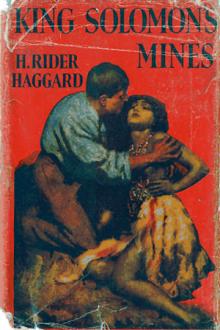King Solomon’s Mines by H. Rider Haggard (inspirational books for women TXT) 📕

- Author: H. Rider Haggard
Book online «King Solomon’s Mines by H. Rider Haggard (inspirational books for women TXT) 📕». Author H. Rider Haggard
For an hour and a half or more we tramped on up the heather-fringed way, going so fast in our excitement that the bearers of Gagool’s hammock could scarcely keep pace with us, and its occupant piped out to us to stop.
“Walk more slowly, white men,” she said, projecting her hideous shrivelled countenance between the grass curtains, and fixing her gleaming eyes upon us; “why will ye run to meet the evil that shall befall you, ye seekers after treasure?” and she laughed that horrible laugh which always sent a cold shiver down my back, and for a while quite took the enthusiasm out of us.
However, on we went, till we saw before us, and between ourselves and the peak, a vast circular hole with sloping sides, three hundred feet or more in depth, and quite half a mile round.
“Can’t you guess what this is?” I said to Sir Henry and Good, who were staring in astonishment at the awful pit before us.
They shook their heads.
“Then it is clear that you have never seen the diamond diggings at Kimberley. You may depend on it that this is Solomon’s Diamond Mine. Look there,” I said, pointing to the strata of stiff blue clay which were yet to be seen among the grass and bushes that clothed the sides of the pit, “the formation is the same. I’ll be bound that if we went down there we should find ‘pipes’ of soapy brecciated rock. Look, too,” and I pointed to a series of worn flat slabs of stone that were placed on a gentle slope below the level of a watercourse which in some past age had been cut out of the solid rock; “if those are not tables once used to wash the ‘stuff,’ I’m a Dutchman.”
At the edge of this vast hole, which was none other than the pit marked on the old Dom’s map, the Great Road branched into two and circumvented it. In many places, by the way, this surrounding road was built entirely out of blocks of stone, apparently with the object of supporting the edges of the pit and preventing falls of reef. Along this path we pressed, driven by curiosity to see what were the three towering objects which we could discern from the hither side of the great gulf. As we drew near we perceived that they were Colossi of some sort or another, and rightly conjectured that before us sat the three Silent Ones that are held in such awe by the Kukuana people. But it was not until we were quite close to them that we recognised the full majesty of these Silent Ones.
There, upon huge pedestals of dark rock, sculptured with rude emblems of the Phallic worship, separated from each other by a distance of forty paces, and looking down the road which crossed some sixty miles of plain to Loo, were three colossal seated forms—two male and one female—each measuring about thirty feet from the crown of its head to the pedestal.
The female form, which was nude, was of great though severe beauty, but unfortunately the features had been injured by centuries of exposure to the weather. Rising from either side of her head were the points of a crescent. The two male Colossi, on the contrary, were draped, and presented a terrifying cast of features, especially the one to our right, which had the face of a devil. That to our left was serene in countenance, but the calm upon it seemed dreadful. It was the calm of that inhuman cruelty, Sir Henry remarked, which the ancients attributed to beings potent for good, who could yet watch the sufferings of humanity, if not without rejoicing, at least without sorrow. These three statues form a most awe-inspiring trinity, as they sit there in their solitude, and gaze out across the plain forever.
Contemplating these “Silent Ones,” as the Kukuanas call them, an intense curiosity again seized us to know whose were the hands which had shaped them, who it was that had dug the pit and made the road. Whilst I was gazing and wondering, suddenly it occurred to me—being familiar with the Old Testament—that Solomon went astray after strange gods, the names of three of whom I remembered—“Ashtoreth, the goddess of the Zidonians, Chemosh, the god of the Moabites, and Milcom, the god of the children of Ammon”—and I suggested to my companions that the figures before us might represent these false and exploded divinities.
“Hum,” said Sir Henry, who is a scholar, having taken a high degree in classics at college, “there may be something in that; Ashtoreth of the Hebrews was the Astarte of the Phoenicians, who were the great traders of Solomon’s time. Astarte, who afterwards became the Aphrodite of the Greeks, was represented with horns like the half-moon, and there on the brow of the female figure are distinct horns. Perhaps these Colossi were designed by some Phoenician official who managed the mines. Who can say?”10
Before we had finished examining these extraordinary relics of remote antiquity, Infadoos came up, and having saluted the Silent Ones by lifting his spear, asked us if we intended entering the “Place of Death” at once, or if we would wait till after we had taken food at midday. If we were ready to go at once, Gagool had announced her willingness to guide us. As it was not later than eleven o’clock—driven to it by a burning curiosity—we announced our intention of proceeding instantly, and I suggested that, in case we should be detained in the cave, we should take some food with us. Accordingly Gagool’s litter was brought up, and that lady





Comments (0)